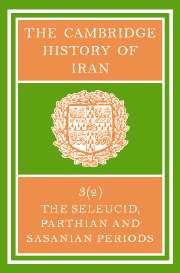Book contents
- Frontmatter
- PART 5 INSTITUTIONS
- PART 6 RELIGIOUS HISTORY
- PART 7 ART HISTORY
- PART 8 LANGUAGES AND LITERATURE
- 31 PARTHIAN WRITINGS AND LITERATURE
- 32(a) ZOROASTRIAN PAHLAVĪ WRITINGS
- (b) THE MANICHAEAN MIDDLE PERSIAN WRITINGS
- (c) MIDDLE PERSIAN INSCRIPTIONS
- 33 SOGDIAN LANGUAGE AND LITERATURE
- 34 KHOTANESE SAKA LITERATURE
- 35 KHWARAZMIAN LANGUAGE AND LITERATURE
- 36 BACTRIAN LITERATURE
- PART 9 BIBLIOGRAPHY
- Bibliography
- Index
- Index of Greek words
- References
34 - KHOTANESE SAKA LITERATURE
from PART 8 - LANGUAGES AND LITERATURE
Published online by Cambridge University Press: 28 March 2008
- Frontmatter
- PART 5 INSTITUTIONS
- PART 6 RELIGIOUS HISTORY
- PART 7 ART HISTORY
- PART 8 LANGUAGES AND LITERATURE
- 31 PARTHIAN WRITINGS AND LITERATURE
- 32(a) ZOROASTRIAN PAHLAVĪ WRITINGS
- (b) THE MANICHAEAN MIDDLE PERSIAN WRITINGS
- (c) MIDDLE PERSIAN INSCRIPTIONS
- 33 SOGDIAN LANGUAGE AND LITERATURE
- 34 KHOTANESE SAKA LITERATURE
- 35 KHWARAZMIAN LANGUAGE AND LITERATURE
- 36 BACTRIAN LITERATURE
- PART 9 BIBLIOGRAPHY
- Bibliography
- Index
- Index of Greek words
- References
Summary
The word “literature” in this chapter heading must be understood to refer to all written documents in the Saka languages, alike the documents of administration and business and the literary texts. Even so the bulk is not large, since much has been lost, though on the literary side of impressive quality.
The name too of the Saka peoples in this chapter has been chosen for its width of application. It has been generally accepted that these documents from Khotan and Tumshuq are from Saka peoples who had become sedentary. The word “Saka”, however, does not appear in the texts themselves. Its justification is the following.
In the Old Persian Achaemenian inscriptions of Pārsa, Darius listed Gandāra Sakā Maka, and wrote hačā Sakaibiš tyaiy para Sugdam “from the Saka who are beyond Sogdiana”; similarly Xerxes has Dahā Sakā. With these is to be joined the statement of Herodotus (VII. 64), oί γàρ Πέρσαι πàντας τoυς Σκυθας καλέoυσι Σακας “for the Persians call all the Skuthas Sakas”. In the 2nd century b.c. the Chinese wrote of Sak (later pronunciation Sö and Sai) to the north-west of Kāshghar. In the second half of the 2nd century b.c. Saka people descended on the Greeks of Bactria and eventually gave their name to ancient Drangiana (Zranka), which has since been called “Land of the Sakas”. Hence this name is found passim. It occurs in a wider sense in the Kharosthī inscription of the Mathurā Lion Capital (mid 2nd century b.c.) as sakastana (k = gh); it is found later in Buddhist Sanskrit as śakasthāna (with ś- replacing s-).
- Type
- Chapter
- Information
- The Cambridge History of IranSeleucid Parthian, pp. 1230 - 1243Publisher: Cambridge University PressPrint publication year: 1983
References
- 1
- Cited by



